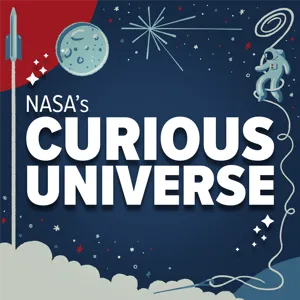Podcast Summary
Protecting Astronauts in Space's Harsh Environment: Spacesuits protect astronauts from extreme temperatures, vacuum, and radiation, enabling them to survive and work in space's harsh conditions
Spacesuits are essential for astronauts to survive and work in the harsh environment of space. Spacesuits are not designed for aesthetics but for functionality, with the primary goal of keeping astronauts alive. Spacesuits protect against extreme temperatures, vacuum, and radiation. Space is not a hospitable environment, and spacesuits serve the same purpose as a spacecraft, providing essential life support and enabling astronauts to perform tasks. Spacesuit engineers face unique challenges in designing these human-shaped spacecraft, considering various hazards, such as extreme temperatures, both hot and cold, and the vacuum of space. The next time astronauts explore beyond Earth's atmosphere, they will rely on the innovative designs and technologies developed by spacesuit engineers to ensure their safety and success.
Astronauts use different types of spacesuits for various space environments: Astronauts wear launch and entry suits during dynamic phases of flight and use microgravity suits for low Earth orbit spacewalks, while planetary walking suits are designed for low-gravity environments like the moon or Mars
Astronauts use different types of spacesuits to survive and work in various space environments. For instance, launch and entry suits, which are worn during dynamic phases of flight, provide pressure and oxygen in case of cabin pressure loss. On the other hand, extravehicular activity (EVA) suits, used for spacewalks and working outside spacecraft, have built-in life support systems. There are two types of EVA suits: microgravity suits, which float in microgravity environments like space stations, and planetary walking suits, designed for low-gravity environments like the moon or Mars. The Apollo extravehicular mobility unit is a versatile suit that combines elements of both, but microgravity suits have been more commonly used since the 1980s for low Earth orbit spacewalks. Planetary walking suits, like the one used during the Apollo moon landings, are less common. Astronauts' lives depend on these suits' ability to adapt to different space environments.
Designing Spacesuits for Space Exploration: Advanced spacesuits are crucial for successful space exploration and vary based on mission and destination. New suits for Artemis program are being developed for long-term lunar and Martian presence, considering terrain and gravity. Analog tests on Earth help understand suit requirements.
The design and functionality of spacesuits are crucial for successful space exploration, and they vary greatly depending on the specific mission and destination. During the Apollo missions, astronauts wore heavy suits that made movement difficult, and they weren't designed for long-term use on the lunar surface. Now, with NASA's Artemis program aiming to establish a long-term presence on the moon and eventually Mars, a new generation of spacesuits is being developed. Axiom Space is building the suits for Artemis astronauts, using NASA's XEMU prototype and decades of spacesuit experience. When designing a new spacesuit, the first consideration is the destination. For example, a suit for microgravity environments like the International Space Station is different from one for lunar or Martian surfaces, where astronauts will need to hike over rough terrain. Testing and designing these suits involves sending scientists to analog environments on Earth to simulate space conditions and understand the suit's requirements. In a recent analog test in Arizona, NASA explored the needs for exploration suits, particularly for geologists conducting geology work on the lunar surface. Overall, the development of advanced spacesuits is essential for extending human presence in space and achieving new milestones in space exploration.
Testing and Feedback for Spacesuit Improvements: NASA rigorously tests and gathers feedback to improve spacesuit design, ensuring full range of motion for astronauts and accommodating diverse body types through modular suits.
NASA's spacesuit design process involves rigorous testing and feedback from various experts, including scientists wearing the suits during field tests. These tests help identify necessary tools and improvements for the suits used in lunar missions, ensuring a full range of motion for astronauts. Spacesuit design is a repetitive process of building, testing, and improving. NASA also tests suit materials in space to understand their impact on the Martian environment. With a diverse new class of astronauts, NASA must design modular suits that can accommodate a wide range of body types, moving away from customized suits of the past.
Components of Space Suits for Long-term Space Missions: Space suits for prolonged missions consist of a pressure garment, portable life support system, and electrical system, each crucial for astronaut survival and functionality.
During prolonged space missions, astronauts will rely on space suits with limited spare parts, making every component crucial. The suits, such as NASA's prototype XEMU, consist of three main parts: the pressure garment, the portable life support system, and the electrical system. The pressure garment, made of fabric and other materials, must be flexible, comfortable, and protective. The portable life support system, a backpack full of essential systems, keeps astronauts alive by circulating air and water. Lastly, the electrical system powers the suit's avionics, enabling astronauts to interact with their spacecraft. Private companies developing suits for the Artemis mission face similar challenges in creating functional, lightweight, and durable components.
Advanced avionics systems crucial for long-term space missions: Advanced avionics systems, including augmented reality tech, enable astronauts to navigate, document findings, and communicate more effectively during long-term space missions to the moon and Mars.
Advanced avionics systems, including augmented reality technology, will be crucial for astronauts during long-term space missions to the moon and Mars due to limited communication with mission control on Earth. These advanced systems will enable astronauts to have more control over their mission plans and spacesuits, as well as provide real-time navigation assistance through heads-up displays. This technology will help astronauts navigate the lunar and Martian surfaces more independently and efficiently, and will also allow them to document their surroundings and catalog new discoveries with improved camera features. NASA engineer Paramita Mitra and her team are leading the development of these advanced display systems for future human spaceflight. The heads-up displays will provide critical mission information in real-time, making navigation and exploration on the lunar and Martian surfaces easier and more efficient. The new camera features will also help astronauts document their findings and provide valuable data to mission control. Overall, these advanced avionics systems will be essential for enabling astronauts to accomplish their science goals and explore new frontiers in space.
NASA's New Space Suits: Integrating Advanced Technology: NASA's new space suits will feature advanced technology like augmented reality displays and intuitive controls to enhance astronaut experience and safety in space.
The future of NASA's space suits is focused on integrating advanced technology, such as augmented reality displays and intuitive controls, to enhance the astronaut's experience and safety in space. These innovations aim to change the way astronauts interact with digital information and improve communication with mission control. The development of new spacesuits is a complex process, prioritizing functionality, mobility, and safety for astronauts, who are treated as valuable assets and family members. The integration of technology is crucial to ensure they can thrive in the challenging conditions of space exploration.
Exploring Space with Advanced Spacesuits: NASA is dedicated to making space exploration safer and more extensive through advanced spacesuits, enabling astronauts to venture deeper into space as part of the Artemis program.
NASA, along with its team and vendors, are dedicated to making space exploration safer and more extensive through advanced spacesuits. As NASA plans to send astronauts back to the moon and eventually to Mars through the Artemis program, these suits will play a crucial role in enabling explorers to venture deeper into space. This commitment to innovation is a significant part of NASA's Curious Universe. If you found this episode interesting, consider leaving a review, sharing it on social media, or following NASA's Curious Universe in your favorite podcast app for future updates. An intriguing thought: imagine a spacesuit designed for an octopus! Such a creation would represent the limitless possibilities of space exploration.






